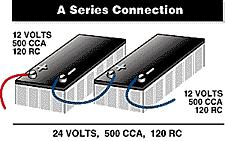|
STARTER
BATTERIES
Battery buying strategy for use in Canada, for example, is different
than in the hot climates found in Texas or Arizona. In the colder
climates, higher CCA ratings are more important. In a hot climate,
higher RC ratings are more important than CCA; however, the CCA rating
must be satisfied and match or exceed your car's OEM (Original Equipment
Manufacturer) cranking amp requirement.
1. Cold Cranking Amps (CCA)
The most important consideration is that the battery's CCA rating MEETS
OR EXCEEDS, your car's OEM cranking requirement in your climate. CCAs
are the discharge load measured in amps that a new, fully charged
battery, operating at 0 o F (-17.8 o C), can deliver for 30 seconds and
while maintaining the voltage above 7.2 volts. Batteries are sometimes
advertised by their Cranking Performance Amps (CA), Marine Cranking Amps
(MCA) measured at 32o F (0 o C), or Hot Cranking Amps (HCA) measured at
80 o F (26.7 o C). These measurements are not the same as CCA. Do not be
misled by CA, MCA or HCA ratings. To convert CAs to CCAs, multiply the
CAs by 0.8. To convert HCAs to CCAs, multiply HCAs by 0.69.]
To start a 4-cylinder gasoline engine, you will need approximately
600-700 CCA; 6-cylinder gasoline engine, 700-800 CCA; 8-cylinder
gasoline engine, 750-850 CCA; 3-cylinder diesel engine, 600-700 CCA;
4-cylinder diesel engine, 700-800 CCA; and 8-cylinder diesel engine,
800-1200 CCA.
In hot climates, buying batteries with double or triple the cranking
amps that exceed your starting requirement can be a WASTE of money.
However, in colder climates the higher CCA rating the better, due to
increased power required to crank a sluggish engine and the inefficiency
of a cold battery. As batteries age, they are also less capable of
producing CCAs. According to the Battery Council International, diesel
engines require 220% to 300% more current than their gasoline
counterparts; winter starting requires 140% to 170% more current than
the summer.
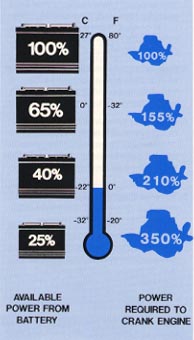
[Source: Exide]
If more CCA capacity is required, two (or more) identical 12-volt car
batteries can be connected in parallel. Please refer to Section 7.2 below
for more information on connecting batteries in parallel. Within a BCI
group size, the battery with more CCA will have more plates because a
larger surface area is required to produce the higher current.
2. Reserve Capacity (RC)
The second most important consideration is the Reserve Capacity rating
because of the effects of increased parasitic (key off) loads and of
emergencies. RC is the number of minutes a fully charged battery at 80
o F (26.7 o C) can be discharged at 25 amps until the voltage falls below
10.5 volts. Deep cycle batteries are usually rated in Ampere-Hours. To
convert Reserve Capacity to approximate Ampere-Hours, multiple RC by 0.4.
For example, a battery with a 120-minute RC will have approximately
48-Ampere-Hours of capacity at the 25-amp discharge rate. More RC is
better in every case! In a hot climate, for example, if your car has a 360
OEM cranking amp requirement, then a 400 CCA rated battery with 120
minutes' RC and more electrolyte for cooling would be more desirable than
one with 1000 CCA with 90 minutes of RC.
The following graph shows the effects of temperature vs. percentage of
capacity:

CAPACITY vs. TEMPERATURE [Source: Concorde]
Adding more Reserve Capacity can be done in two ways. The best way is to
add a deep cycle battery and a diode isolator to your existing car
battery. This is a standard setup in most Recreational Vehicles (RVs). The
advantage of this multi-battery setup is that the high-powered accessories
can be powered from a deep cycle battery (or batteries) and the car
battery is available to start the engine. The second advantage of using a
deep cycle battery to power the high-powered accessories is that it can be
discharged and recharged hundreds of times without damaging the battery. A
car battery is not designed for deep discharges and will have a very short
life if it is abused by deep discharges. A third advantage is that both
batteries will be recharged automatically when the charging system has
power available. An excellent and easy to understand free booklet,
Introduction to Batteries and Charging Systems, written by Ralph Scheidler
and about multi-battery applications, can be obtained from http://www.surepower.com/ebrochures.html
or by calling (800) 845-6269 or (503) 692-5360.
The second way of increasing Reserve Capacity is by replacing the existing
car battery with a large, 12-volt deep cycle battery or two identical
large six-volt deep cycle batteries connected in series (connect the
positive terminal of Battery One to the negative terminal of Battery Two).
The deep cycle batteries must have enough current capacity to start the
engine in the worst-case temperature.
If more ampere-hours (or CCA) are required, two (or more) new and
identical 12-volt batteries can be connected in parallel. If you connect
two 12-volt batteries in parallel, and they are identical in type, age and
capacity, you can potentially double you original capacity. If you connect
two that are not the same type, you will either overcharge the smaller of
the two, or you will undercharge the larger of the two.
The recommended parallel and series connections are as follows:
[Source: Interstate Batteries]
Connected this way the batteries will discharge and recharge equally.
When connecting in series or parallel and to prevent recharging problems,
do NOT mix old and new batteries or ones with different types. Cable
lengths should be kept short and the cable should be sized large enough to
prevent significant voltage drop [.2 volts (200 millivolts) or less]
between batteries.
7.3. Type
The three most common types of CAR batteries are wet low maintenance
(non-sealed), wet maintenance free (non-sealed or sealed), and
gas-recombinant absorbed glass mat (AGM). The low maintenance batteries
have a lead-antimony/calcium (dual alloy or hybrid) plate formulation.
Maintenance free batteries have a lead-calcium/calcium formulation.
Some of the battery manufacturers, such as Johnson Controls, build
"North" and"South" battery versions to make up for the
differences in climates. The advantages of maintenance free batteries are
less preventive maintenance, up to 250% less water loss, faster
recharging, greater overcharge resistance, reduced terminal corrosion, up
to 40% more life cycles, up to 200% less self discharge, and less danger
to consumers because there is less to service. However, they are more
prone to deep discharge (dead battery) failures due to increased
shedding of active plate material and development of a barrier layer
between the active plate material and the grid metal. If sealed, a
shorter life in hot climates is often experienced because water cannot be
replaced. Maintenance free batteries are generally more expensive than low
maintenance batteries. In hot climates, buying non-sealed
"South"-type low maintenance, maintenance free or absorbed glass
mat (AGM) battery is recommended.
|
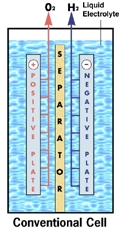
|

|
[Source:
Hawker]
If you replace a sealed maintenance free battery in a GM car with a
non-sealed lead-antimony or lead-antimony/calcium low maintenance battery,
you will need to check the electrolyte levels more often. This is
because GM sets their voltage regulators at higher charging voltage, 14.8
volts, to recharge the sealed maintenance free lead-calcium/calcium
batteries, like the original AC Delco batteries.
Sears has introduced a DieHard Security for approximately $170. When the
ignition key is switched off, the battery will not allow the engine to be
started but will provide power for the parasitic or "key off"
load. Consumer Reports has tested it and indicates in the October, 2000
issue, that a car thief can defeat the security feature in less than one
minute.
In the future, you can expect more expensive AGM or recombinant gas
technology (GRT) batteries in the $100 to $150 price ranges. Examples of
AGM batteries are Optima, Interstate's Extreme Performance, Concorde's
Lifeline, Delphi's Freedom Extra, Exide's Select Orbital, AC Delco's
Platinum, and Champion's Vortex. The use of this technology is because car
manufacturers want to extend their "bumper-to-bumper" warranty
periods, to relocate the battery from under the hood to avoid temperature
extremes, to provide more weight in the rear, or to save under-hood space.
The advantages of AGM batteries are they are maintenance free without the
disadvantages of wet lead acid maintenance free batteries; they will last
two to three times longer, if not overcharged. An AGM battery can replace
a wet low maintenance battery, but a wet low maintenance battery cannot
replace an AGM battery without adjusting the charging voltages. Expect
to see 36-volt AGM car batteries with 14/42-volt dual or 42-volt
electrical systems introduced by some of the car manufacturers in 2002.
For off road applications in trucks, recreational vehicles (RVs), 4x4's,
vans or sport utility vehicles (SUV's), some manufacturers distribute
"high vibration" or RV battery versions designed to reduce the
effects of moderate vibration. For excessive vibration applications such
as is experienced in off-road operation, it is best to use an AGM battery
because there is no shedding of active plate material since the plates are
immobilized. Some manufacturers construct special batteries that have a
higher tolerance to heat by changing plate formulations or providing for
more electrolyte.
Car batteries are specially designed for high initial amps applications
and shallow discharges. Cars usually start in five to 15 seconds; to start
an enginetypically consumes 5%-10% of the battery's capacity. Car
batteries should NOT be discharged below 90% state-of-charge. By contrast,
marine batteries are designed for prolonged discharges at lower amperage
that typically consumes between 20% and 50% of the battery's capacity and
deep cycle the batteries in a range between 20% and 80%. A
"dual" or starting marine battery is a compromise between a car
and deep cycle battery that is specially designed for marine applications.
A deep cycle or "dual marine" battery will work as a starting
battery if it can produce enough current to start the engine. For
saltwater applications, AGM or gel cell batteries are highly recommended
to prevent the formation of high levels of chorine gas.
4. Size and Terminals
Manufacturers build their batteries to an internationally adopted Battery
Council International (BCI) group number (24, 26, 70, 75, etc.). These
specifications, which are based on the physical case size, terminal
placement, type and polarity is used extensively in North America. In
Europe, the EN, IKC, Italian CEI, and German DIN standards are used and in
Asia, the Japanese JIS standard is used. The OEM battery group number
is a good starting place to determine the replacement group. Within a
group, the CCA and RC ratings, warranty and battery type will vary within
models of the same brand or from brand to brand. Batteries are generally
sold by model, so the group numbers will vary for the same price. This
means that for the SAME price, you can potentially buy a physically larger
battery with more CCA or RC than the battery you are replacing. For
example, a 34/78 group might replace a smaller 26/70 group and give you an
additional 200 CCA or 30 minutes of RC. If you buy a physically larger
battery, be sure that the replacement battery will fit, the cables will
connect to the correct terminals, and that the terminals will NOT touch
surfaces such as the hood when it is closed.
BCI and the battery manufacturers publish application guides that contain
OEM cranking amperage requirements and group number replacement
recommendations by make, model and year of car, battery size, and CCA and
RC specifications. You can also find BCI size information online at
http://www.exidebatteries.com/bci.cfm. Manufacturers might not build or
the store might not carry all the BCI group numbers. To reduce inventory
costs, dual terminal "universal" batteries that will replace
several group sizes are becoming more popular and fit 75% or more of cars
on the road today.
There are six types of battery terminals-SAE Post, GM Side, "L",
Stud, combination SAE and Stud, and combination S.A.E Post and GM Side.
For automotive applications, the SAE Post is the most popular, followed by
GM Side, then the combination "dual" SAE Post and GM Side.
"L" terminal is used on some European cars, motorcycles, lawn
and garden equipment, snowmobiles, and other light duty vehicles. Stud
terminals are used on heavy duty and deep cycle batteries. The positive
SAE Post terminal in slightly larger (by 1/16") than the negative
one. Terminal locations and polarity will vary.
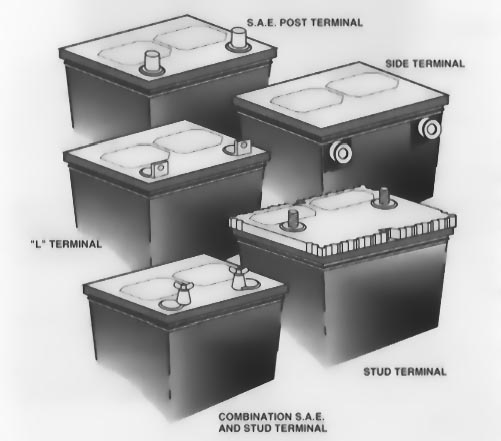
[Source: BCI]
Battery manufacturers or distributors will often "private label"
their batteries for large chain stores. An alphabetical list in order of
the largest battery manufacturers/distributors in North America and some
of their brand names, trademarks and private labels maybe found at:
http://www.uuhome.de/william.darden
or contact Bill Darden
Email: bjb_darden@yahoo.com.
Ownership,
branding, Web addresses and telephone numbers are subject to change. For
example, on September 29, 2000, Exide purchased GNB and Johnson Controls
purchased Gylling Optima. Exide is the largest battery manufacturer in the
world, and Johnson Controls is the largest manufacturer in the Americas.
5. Freshness
Determining the "freshness" of a battery is sometimes difficult.
NEVER buy a wet lead acid battery that is MORE than THREE months old
because it has started to sulfate unless it has periodically been
recharged or it is "dry charged." The exceptions to this rule
are AGM and Gel Cell batteries that can be stored up to 12 months before
the state-of-charge drops below 80%. Please see Section 16 for more
information on sulfation. Dealers will often place their older batteries
in storage racks so they will sell first. The new batteries can often be
found in the rear of the rack or in a storage room. The date of
manufacture is stamped on the case or printed on a sticker.
Some of the manufacturers date coding techniques are as follows:
6.1. Delphi (AC Delco and some Sears DieHard)
Dates are stamped on the cover near one post. The first number is the
year. The second character is the month A-M, skipping I. The last two
characters indicate geographic areas. Example 0BN3=2000 February.
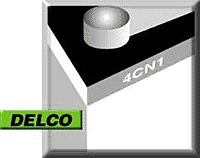
[Source: Interstate Batteries]
6.2. Douglas
Douglas uses the letters of their name to indicate the year of manufacture
and the digits 1-12 for the month. D=1994 O=1995 U=1996 G=1997 L=1998
A=1999 S=2000 Example S02=2000 Feb.
6.3.
East
Penn, GNB (Champion), and Johnson Controls Inc. (Interstate and some Sears
DieHard)
Usually on a sticker or hot-stamped on the side of the case. A=January,
B=February, and the letter I is skipped. The number next to the letter is
the year of SHIPMENT. Example B0=Feb 2000
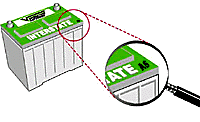
[Source: Interstate Batteries]
6.4. Exide (some Sears non-Gold DieHards)
The fourth or fifth character is the month. The following numeric
character is the year. A-M skipping I. Example RO8B0B=Feb. 2000.

[Source: Interstate Batteries]
6.5. Trojan
Stamp on post, 2 Months AFTER manufacture date.
If you cannot determine the date code, ask the dealer or contact the
manufacturer. Like bread, fresher is definitely better and does matter.
7. Warranty
As with tire warranties, battery warranties are NOT necessarily indicative
of the quality or cost over the life of the battery. Most manufacturers
will prorate warranties based on the LIST price of the bad battery, so if
a battery failed half way or more through its warranty period, buying a
NEW battery outright might cost you less than paying the difference under
a prorated warranty. The exception to this is the FREE replacement
warranty and represents the risk that the manufacturer is willing to
assume. A longer free replacement warranty period is better.
SOLAR
RICKSHAW STORAGE BRIEF
A
project to design and build a solar powered rickshaw is under way in
Sussex, England, part sponsored by Bluebird Batteries and Bluebird
Marine Systems Ltd. The brief is to replace the existing
auto-rickshaws powered by inefficient 2 stroke engines, with electric
rickshaws powered in the main directly by solar
panels. In
order to provide the necessary range for a whole days work, the solar
rickshaw will need to store energy produced by its solar panels in a
battery or other storage device. Although regenerating fuels cells
might be a viable option in the future, at present this technology is
not far enough advanced, and far too expensive in any event.
However, Lithium Polymer cells are coming down in price. These cells will reduce the mass of
storage medium to acceptable levels and provide long term savings if
running costs.
Please
click on the links above to find out about these famous automotive
makers. If your company is not included and you would like to be
listed, please let us know.
CONTACTS
A
taste for adventure
capitalists
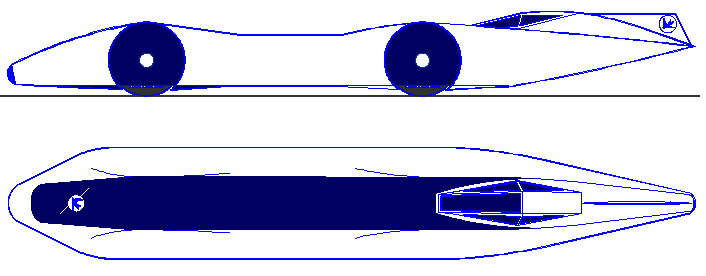
The
world's fastest battery electric car: 350mph + using energy from nature.
Featuring built in battery cartridge exchange, charged using renewable
solar energy. Sponsors sought for the 2016 season.
LEAD-WEDGE
SILVER-EAGLE
BATTERY-BOX
LIGHTNING-ROD WHITE-LIGHTNING
BUCKEYE
BULLET EMOTION
|



